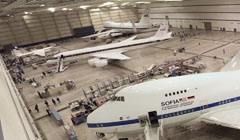
| Dryden Aircraft
Operations Facility Dedicated to Earth, Space Science |
|
|
4/9/2009 - PALMDALE, CA – NASA dedicated its new Dryden Aircraft Operations Facility in Palmdale, Calif., a world-class facility that is home to several specialized NASA Earth and space science aircraft, during ceremonies on Thursday, April 9. The event drew local, regional, state and federal officials along with several hundred guests to the cavernous hangar and office complex adjacent to the U.S. Air Force Production Flight Test Plant 42. The former aircraft assembly hangar and office structure is a satellite facility of NASA's Dryden Flight Research Center at Edwards Air Force Base. "This facility is unlike any other, providing the space we need to manage and operate a suite of unique aircraft," said NASA Dryden's acting director, David D. McBride. "This facility is about more than aircraft. It will support a constant flow of people coming to the Antelope Valley. Science campaigns by earth scientists and astrophysicists to gather the facts, increase our understanding of our planet, and about our universe." Mayor James C. Ledford Jr. of the City of Palmdale noted that establishment of the facility is the result of a collaborative partnership between NASA and several local and regional agencies, along with research institutions around the globe. He cited as an example the international partnership represented in the Stratospheric Observatory for Infrared Astronomy (SOFIA) that is based on the facility. "We are going to have scientists from all over the world," he added. "We need to be prepared to be hosts. We need to be prepared to learn what others might be bringing besides their technologies. They will be bringing their cultures. I find that to be very, very exciting. "What this facility represents is huge as far as aeronautical engineering that keeps us on the cutting edge, and it is a source of national pride,” Ledford concluded. That theme was echoed in comments from U.S. Rep. Howard P. "Buck" McKeon of California's 25th congressional district, who said he couldn't think of a more fitting home for a NASA research facility and laboratory than Palmdale. "The Dryden Aircraft Operations Facility…will provide not only a great addition to Dryden’s mission capabilities, but also an incredible tool for collaborations among industry, universities, government and international partners,” said McKeon. Five NASA science aircraft are either currently based at the facility or soon will be, including a DC-8 flying science laboratory, the SOFIA 747SP, two ER-2 high-altitude aircraft and a Gulfstream III. The consolidation of these aircraft at one facility creates a considerable cost savings to the American taxpayer by sharing maintenance and fleet operations at one facility devoted to the support of science missions. Missions launched from the facility will address a variety of science disciplines, including astronomy, climate change, tropical storm development, intercontinental pollution, earthquake and volcanic activity, vegetation and eco-system studies, and glacier dynamics and sea ice research in the Arctic and Antarctic. Steve Volz, Associate Director for Flight Programs for NASA's Earth Science division in Washington, D.C., pointed out the criticality of specialized science aircraft to both supplement as well as validate the data obtained from environmental satellites in orbit around the planet. "We have over 15 satellites in orbit right now and seven more in development," said Volz. "These are billion-dollar missions, multi-billion-dollar missions, or investments. The only way we can accomplish the groundbreaking Earth science from orbit is by (having) a healthy and vigorous airborne sciences program. Volz noted that airborne science performs a variety of roles for NASA's science missions, including calibration of instruments while flying under satellite orbital tracks. "A picture from space…doesn’t mean anything if we don’t know it’s absolutely accurate," Volz said. "The DC-8, the ER-2 and the G-III…carry calibration instruments that enable us to know what we are measuring from space – whether it’s global ice change, atmospheric chemistry change – are correct because we cannot go up in space and recalibrate our instruments. "They also…provide a way to develop new instrumentation," he added. "If it takes a billion dollars to launch a satellite, you want to make very certain that your instrument works properly. These airplanes provide that necessary test bed to try out as many as 15 to 20 instruments at a time through different environments to see how the measurements work. A few hundred thousand dollars on an airplane can save tens of millions of dollars on a satellite development activity. It really is a bridge to orbit for satellites," Volz concluded. NASA refurbished the main building to provide a state-of-the-art facility for scientists ranging from undergraduate students to experts in key disciplines. Universities and research organizations from around the world will enjoy the convenience and accessibility of the NASA Dryden facility in Palmdale. Built originally by Rockwell International's North American Aircraft Division for final assembly of the U.S. Air Force B-1 Lancer bomber in the early 1980s, the 422,000-sq.-foot structure includes offices and laboratories for preparation, integration and testing of complex airborne instruments. Situated on 16.2 acres, the facility has easy access to the adjacent taxiways and runways at U.S. Air Force Plant 42. Source: NASA Press Release |
| |
